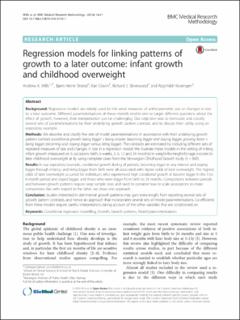| dc.description.abstract | Background: Regression models are widely used to link serial measures of anthropometric size or changes in size to a later outcome. Different parameterisations of these models enable one to target different questions about the effect of growth, however, their interpretation can be challenging. Our objective was to formulate and classify several sets of parameterisations by their underlying growth pattern contrast, and to discuss their utility using an expository example.
Methods: We describe and classify five sets of model parameterisations in accordance with their underlying growth pattern contrast (conditional growth; being bigger v being smaller; becoming bigger and staying bigger; growing faster v being bigger; becoming and staying bigger versus being bigger). The contrasts are estimated by including different sets of repeated measures of size and changes in size in a regression model. We illustrate these models in the setting of linking infant growth (measured on 6 occasions: birth, 6 weeks, 3, 6, 12 and 24 months) in weight-for-height-for-age z-scores to later childhood overweight at 8y using complete cases from the Norwegian Childhood Growth study (n = 900).
Results: In our expository example, conditional growth during all periods, becoming bigger in any interval and staying bigger through infancy, and being bigger from birth were all associated with higher odds of later overweight. The highest odds of later overweight occurred for individuals who experienced high conditional growth or became bigger in the 3 to 6 month period and stayed bigger, and those who were bigger from birth to 24 months. Comparisons between periods and between growth patterns require large sample sizes and need to consider how to scale associations to make comparisons fair; with respect to the latter, we show one approach.
Conclusion: Studies interested in detrimental growth patterns may gain extra insight from reporting several sets of growth pattern contrasts, and hence an approach that incorporates several sets of model parameterisations. Co-efficients from these models require careful interpretation, taking account of the other variables that are conditioned on. | en_US |
